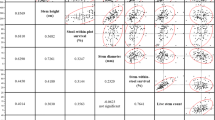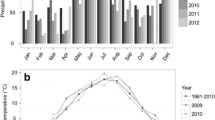Abstract
The global community needs a sustainable and renewable sources of energy as alternatives to finite fossil fuels that are also associated with climate change. Eastern cottonwood (Populus deltoides Bartr.) is a fast-growing candidate for cultivation as a short-rotation woody crop for biofuel production and it is planted throughout Asia, Europe, and the Northern America. It is native to the Lower Mississippi Alluvial Valley (LMAV) of the South Central United States. The LMAV has climatic, edaphic, and infrastructural attributes conducive to biofuel production, but much of the most productive sites of the region are dedicated to agricultural production because it is the most economically prime use. To foster development of a biofuel industry of the region may require biomass production on sites suboptimal for agricultural production. In this study, cropping systems and genotypes for cottonwood production were tested at three retired agricultural sites in the LMAV, Archibald, Colt, and Rohwer. Cropping systems tested were monoculture and alley cropping systems with two different alley widths. Genotypes tested were clones from Mississippi (ST-66) and Texas (S7C20) and a mixture of clones from Louisiana (LAMIX). Several interactions among site, genotype, and cropping system treatments were detected in survival and growth parameters. By the end of the study period, survival ranged from 30 to 81%, while height and diameter at breast height (dbh) ranges were 3.12–5.78 m, and 2.09–4.39 cm, respectively. Overall, survival and growth performance in this study were low compared to previous studies, suggesting the difficulty of managing productive cottonwood plantations under the suboptimal site conditions tested. Pronounced droughts during half of the years in this study and poor soil conditions were likely the primary reasons behind such performance of the genotypes. The study found no effect of cropping systems on individual tree growth. Genotypes from Texas and Louisiana showed relatively better survival (P = 0.0029) and growth (P < 0.001 to P = 0.0207) than the clone from Mississippi in the site conditions tested. Among sites, Rohwer, which had deep clay soil, had the highest biomass production (8299 kg ha−1). Survival and growth was limited at the Archibald site by ponding of water in winter and early spring in the establishment year and 2 years of pronounced drought in following years. A greater recurrence of competing vegetation at Archibald likely contributed to its lower survival (30%) and growth (biomass ranging from 1026 to 1511 kg ha−1 among the treatments) by the end of the study period. We suggest selecting drought-hardy genotypes along with site preparation and fertilization in such marginal sites.


Similar content being viewed by others
References
Benjamin JG, Lilieholm RJ, Damery D (2009) Challenges and opportunities facing the northeastearn forest bioindustry. J For 107:125–131
Bhattarai N, Shaw SB, Quackenbush LJ, Im J, Niraula R (2016) Evaluating five remote sensing based single-source surface energy balance models for estimating daily evapotranspiration in a humid subtropical climate. Int J Appl Earth Obs Geoinf 49:75–86. doi:10.1016/j.jag.2016.01.010
Blanco-Canqui H (2010) Energy crops and their implications on soil and environment. Agron J 102:403–419. doi:10.2134/agronj2009.0333
Blazier MA, Clason TR, Liechty HO, Leggett ZH, Surcre EB, Roberts SD, Krapfl K, Vance ED (2015) Nitrogen and carbon of switchgrass, loblolly pine, and cottonwood biofuel production systems in the Southeast United States. For Sci 61:522–534. doi:10.5849/forsci.14-016
Carter MC, White EH (1971) The necessity for intensive cultural treatment in cottonwood plantations. Ala Agric Exp Stn Circ 189. Auburn Univ, Auburn
Clark JS, Iverson L, Woodall CW, Allen CD, Bell DM, Bragg DC, D’Amato AW, Davis FW, Hersh MH, Ibanez I, Jackson ST, Matthews S, Pederson N, Peters M, Schwartz MW, Waring KM, Zimmermann NE (2016) The impacts of increasing drought on forest dynamics, structure, and biodiversity in the United States. Glob Chang Biol 17:1–23. doi:10.1111/gcb.13160
Coleman MD, Friend AL, Kern CC (2004) Carbon allocation and nitrogen acquisition in a developing Populus deltoides plantation. Tree Physiol 24:1347–1357. doi:10.1093/treephys/24.12.1347
Cooper DT (1990) Populus deltoides Bartr ex Marsh eastern cottonwood. In: Burns RM, Honkala BH, tech coords Silvics of North America: hardwoods. Agric Handb 654, p 877, vol 2. U.S. Department of Agriculture, Forest Service, Washington
Coyle DR, Coleman MD (2005) Forest production responses to irrigation and fertilization are not explained by shifts in allocation. For Ecol Manage 208:137–152. doi:10.1016/j.foreco.2004.11.022
Coyle D, Coleman M, Durant J, Newman L (2006) Survival and growth of 31 Populus clones in South Carolina. Biomass Bioenergy 30:750–758. doi:10.1016/j.biombioe.2005.08.005
Dipesh KC, Schuler JL (2013) Fine-root production and aboveground development for loblolly pine, silver maple, and cottonwood. Commun Soil Sci Plant Anal 44:2207–2218. doi:10.1080/00103624.2013.794822
Dipesh KC, Will RE, Hennessey TC, Penn CJ (2015a) Evaluating performance of short-rotation woody crops for bioremediation purposes. New For 46:267–281. doi:10.1007/s11056-014-9460-6
Dipesh KC, Will RE, Lynch TB, Heinemann R, Holeman R (2015b) Comparison of loblolly pine, shortleaf, and pitch × loblolly pine plantations growing in Oklahoma. For Sci 61(3):540–547. doi:10.5849/forsci.14-004
Fortier J, Gagnon D, Truax B, Lambert F (2010) Biomass and volume yield after 6 years in multiclonal hybrid poplar riparian buffer strips. Biomass Bioenergy 34:1028–1040. doi:10.1016/j.biombioe.2010.02.011
Francis JK, Baker JB (1981) Biomass and nutrient accumulation in a cottonwood plantation-the first four years. USDA Forest Service, Southern Research Station, Res Note SO-278
Heilman PE (1999) Planted forests: poplars. New For 17(1):89–93. doi:10.1023/A:1006515204167
Hoffmann D, Weih M (2005) Limitations and improvement of the potential utilisation of woody biomass for energy derived from short rotation woody crops in Sweden and Germany. Biomass Bioenergy 28:267–279. doi:10.1016/j.biombioe.2004.08.018
Holzmueller EJ, Jose S (2012) Biomass production for biofuels using agroforestry: potential for the North Central Region of the United States. Agrofor Syst 85:305–314. doi:10.1007/s10457-012-9502-z
Jain SK, Singh P (2000) Economic analysis of industrial agroforestry: poplar (Populus deltoides) in Uttar Pradesh (India). Agrofor Syst 49:255–273. doi:10.1023/A:1006388128069
Joshi O, Mehmood SR (2011) Factors affecting nonindustrial private forest landowners’ willingness to supply woody biomass for bioenergy. Biomass Bioenergy 35:186–192. doi:10.1016/j.biombioe.2010.08.016
Kabba BS, Knight JD, van Rees KCJ (2009) Nutrient uptake of hybrid poplar in competition with weeds using the soil supply and nutrient demand (SSAND) model. Can J Soil Sci 89:197–207. doi:10.4141/CJSS08006
Kabrick JM, Dey DC, Jensen RG, Wallendorf M (2008) The role of environmental factors in oak decline and mortality in the Ozark Highlands. For Ecol Manage 255:1409–1417. doi:10.1016/j.foreco.2007.10.054
Kang S, Post WM, Nichols JA, Wang D, West TO, Bandaru V, Izaurralde RC (2013) Marginal lands: concept, assessment and management. J Agric Sci 5:129–139. doi:10.5539/jas.v5n5p129
Krinard RM, Kennedy HE (1980) Five-year-old cottonwood plantation on a clay site: growth, yield, and soil properties. South J Appl For 4(2):80–83
Kszos LA, Downing ME, Wright LL, Cushman JH, McLaughlin SB, Tolbert VR, Tuskan GA, Walsh ME (2001) Bioenergy feedstock development program Status Report, ORNL/TM-2000/292, Oak Ridge National Laboratory, Oak Ridge, TN. http://www.ornl.gov/~webworks/cppr/y2001/rpt/108677_.pdf. Accessed 4 March 2016
Liechty H, Vance ED, Blazier MA, Pelkki M, White Jr. D, Robinson Z (2012) The potential for using agroforests for bioenergy production in the Lower Mississippi Alluvial Valley. In: Meyer SP (ed) pp 88–92 in IUFRO 3.08.00 small-scale forestry conference 2012: science for solutions conference proceedings. Family Forest Research Center, Amherst
Mohn CA, Randall WK, McKnight JS (1970) Fourteen cottonwood clones selected for midsouth timber production. US Dep Agric For Serv Res Pap SO-62:1–17
National Cooperative Soil Survey (2002) National cooperative soil survey characterization database. https://soilseries.sc.egov.usda.gov/OSD_Docs/C/CALLOWAY.html. Accessed 4 March 2016
National Cooperative Soil Survey (2003a) National cooperative soil survey characterization database. https://soilseries.sc.egov.usda.gov/OSD_Docs/G/GILBERT.html. Accessed 11 Nov 2016
National Cooperative Soil Survey (2003b) National cooperative soil survey characterization database. https://soilseries.sc.egov.usda.gov/OSD_Docs/E/EGYPT.html. Accessed 4 March 2016
National Cooperative Soil Survey (2013a) National cooperative soil survey characterization database. https://soilseries.sc.egov.usda.gov/OSD_Docs/H/HENRY.html. Accessed 4 March 2016
National Cooperative Soil Survey (2013b) National cooperative soil survey characterization database. https://soilseries.sc.egov.usda.gov/OSD_Docs/S/SHARKEY.html. Accessed 4 March 2016
National Cooperative Soil Survey (2013c) National cooperative soil survey characterization database. https://soilseries.sc.egov.usda.gov/OSD_Docs/F/FOLEY.html. Accessed on 4 March 2016
Nepal S, Contreras MA, Lhotka JM, Stainback GA (2014) A spatially explicit model to identify suitable sites to establish dedicated woody energy crops. Biomass Bioenergy 71:245–255. doi:10.1016/j.biombioe.2014.10.002
O’Connor GA, Elliott HA, Basta NT, Bastian RK, Pierzynski GM, Sims RC, Smith JE (2005) Sustainable land application: an overview. J Environ Qual 34:7–17
Puri S, Swamy SL, Jaiswal AK (2002) Evaluation of Populus deltoides clones under nursery, field and agrisilviculture system in subhumid tropics of Central India. New For 23:45–61. doi:10.1023/A:1015620915654
Ranney JW, Wright LL, Layton PA (1987) Hardwood energy crops: the technology of intensive culture. J For 85:17–28
Robertson GP (2014) Soil greenhouse gas emissions and their mitigation. Encycl Agric Food Syst 5:185–196. doi:10.1016/B978-0-444-52512-3.00097-8
Saud P, Wang J, Lin W, Sharma BD, Hartley DS (2013) A life cycle analysis of forest carbon balance and carbon emissions of timber harvesting in West Virginia. Wood Fiber Sci 45(3):250–267
Savolainen O, Pyhäjärvi T, Knürr T (2007) Gene flow and local adaptation in trees. Annu Rev Ecol Evol Syst 38:595–619. doi:10.1146/annurev.ecolsys.38.091206.095646
Schuler JL, McCarthy W (2015) Development of eastern cottonwood cuttings as modified by cutting length and surface area available for rooting. New For 46:547–559. doi:10.1007/s11056-015-9482-8
Schultz RC, Isenhart TM, Simpkins WW, Colletti JP (2004) Riparian forest buffers in agroecosystems—lessons learned from the Bear Creek Watershed, central Iowa, USA. Agrofor Syst 61–62:35–50. doi:10.1023/B:AGFO.0000028988.67721.4d
Swamy SL, Mishra A, Puri S (2006) Comparison of growth, biomass and nutrient distribution in five promising clones of Populus deltoides under an agrisilviculture system. Bioresour Technol 97:57–68. doi:10.1016/j.biortech.2005.02.032
Thomas BR, Schreiber SG, Kamelchuk DP (2016) Impact of planting container type on growth and survival of three hybrid poplar clones in central Alberta, Canada. New For 47(6):815–827. doi:10.1007/s11056-016-9546-4
Tripp S, Powell R, Nelson P (2009) Regional strategy for biobased products in the Mississippi Delta, report by Battelle Technology Partnership Practice. BioDimensions Inc., Memphis
Udawatta RP, Jose S (2012) Agroforestry strategies to sequester carbon in temperate North America. Agrofor Syst 86:225–242. doi:10.1007/s10457-012-9561-1
USDA-NRCS (2016) Web soil survey. http://websoilsurvey.sc.egov.usda.gov/App/WebSoilSurvey.aspx. Accessed 7 March 2016
Wright L, Turhollow A (2010) Switchgrass selection as a “model” bioenergy crop: a history of the process. Biomass Bioenergy 34:851–868. doi:10.1016/j.biombioe.2010.01.030
Zalesny JA, Zalesny RS Jr, Wiese AH, Hall RB (2007) Choosing tree genotypes for phytoremediation of landfill leachate using phyto-recurrent selection. Int J Phytoremediat 9:513–530. doi:10.1080/15226510701709754
Zalesny JA, Zalesny RS Jr, Wiese AH, Sexton BT, Hall RB (2008) Uptake of macro- and micro-nutrients into leaf, woody, and root tissue of Populus after irrigation with landfill leachate. J Sustain For 27:303–327. doi:10.1080/10549810802256262
Zalesny RS Jr, Hall RB, Zalesny JA, McMahon BG, Berguson WE, Stanosz GR (2009) Biomass and genotype × environment interactions of Populus energy crops in the midwestern United States. Bioenergy Res 2:106–122. doi:10.1007/s12155-009-9039-9
Acknowledgements
The authors gratefully acknowledge financially support for this project by grants from the U.S. Department of Agriculture (USDA) Sustainable Agriculture Research and Education program, South Central Sun Grant program, and the USDA Agriculture and Food Research Initiative (Grant 2011-67010-20078). The authors also appreciate Stacy Wilson, Allen Humphrey, Michelle Gonzales, Kenny Kidd, and Brad Osbon for their assistance in collecting these data.
Author information
Authors and Affiliations
Corresponding author
Rights and permissions
About this article
Cite this article
Dipesh, K.C., Blazier, M.A., Pelkki, M.H. et al. Genotype influences survival and growth of eastern cottonwood (Populus deltoides L.) managed as a bioenergy feedstock on retired agricultural sites of the Lower Mississippi Alluvial Valley. New Forests 48, 95–114 (2017). https://doi.org/10.1007/s11056-016-9558-0
Received:
Accepted:
Published:
Issue Date:
DOI: https://doi.org/10.1007/s11056-016-9558-0




